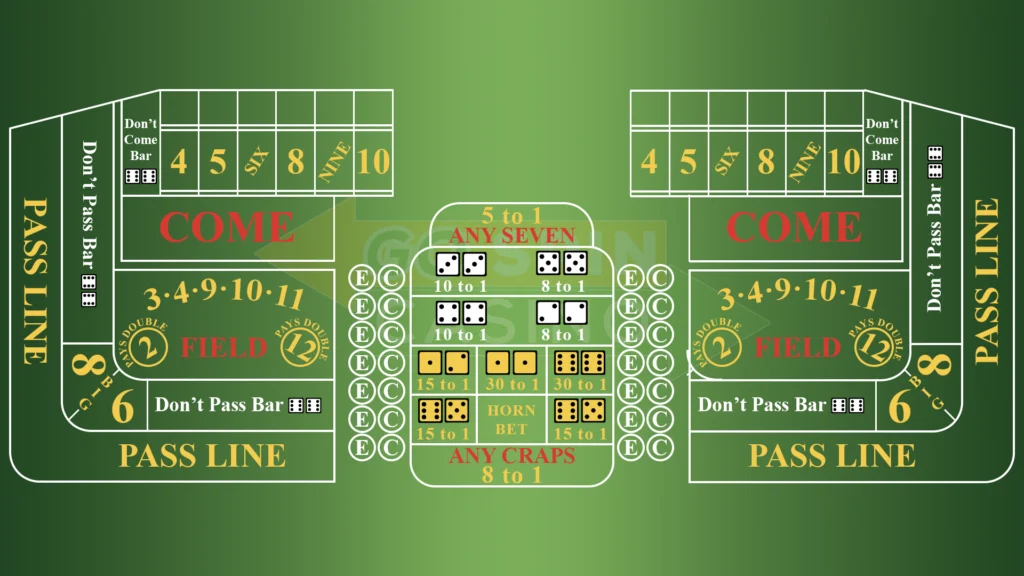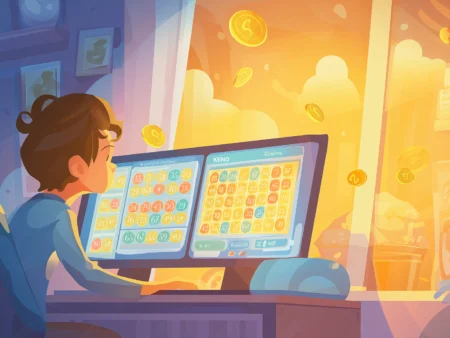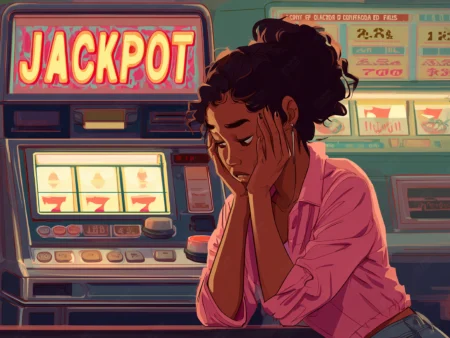Most players walk up to a craps table and feel overwhelmed. Dice are flying, players are shouting, chips are stacking, it looks chaotic, even random. But that’s exactly what makes craps such a misunderstood opportunity.
Beneath the noise is a game with structure, rhythm, and, most importantly, strategy. A solid craps strategy isn’t about luck. It’s about knowing where to place your bets, when to stay out, and how to stretch your edge.
This isn’t about controlling the dice or betting on hunches. It’s about understanding the flow of the game, sticking to the smartest bets, and managing your bankroll like someone who’s here to win, not just roll.
Yes, craps is still a gamble. But the right strategy can stretch your session, protect your stack, and even give you a shot at real, consistent wins.
Here’s how pros approach the game, and how you can bet smarter from your very next roll.
Table of contents
- How Craps Really Works, And Why Strategy Matters
- The Core of Any Craps Strategy: Know Your Bets
- Advanced Craps Strategies That Pros Actually Use
- The Worst Bets in Craps (Avoid These Like the Plague)
- Reading the Table: Timing, Etiquette, and Flow
- Where to Practice and Play Craps Online
- Final Word: Craps Isn’t a Guessing Game, Play It Like a Pro
- Craps FAQs
How Craps Really Works, And Why Strategy Matters
Craps might look like a frenzy, but it runs on a simple engine: dice, probabilities, and payouts. Two six-sided dice, 36 possible combinations, and a handful of bets that can make or break your bankroll.
Most players lose at craps not because the game is unfair, but because they have no idea where their money’s going. They chase flashy bets, fall for table superstitions, or copy whatever the loudest guy at the table is doing.
That’s not a strategy, that’s donating to the house.
The reality? Craps has some of the best odds in the casino, if you bet smart. We’re talking house edges under 1%, something you won’t find in slots, roulette, or even blackjack (unless you’re counting cards).
So what separates casual players from strategic ones?
It’s not about memorizing every square inch of the layout. It’s about locking into a handful of mathematically sound bets, ones that give you the most value for every chip you put down. The rest? Noise. Expensive noise.

Here’s where most players go wrong:
- They bet on every roll instead of waiting for strong positions
- They skip the odds behind the Pass Line, the most valuable bet on the table
- They toss chips on high-risk props without realizing the math is stacked against them
If you want to play like a pro, start thinking like one. Every chip should have a purpose. Every bet should be a calculated move, not just a gut feeling.
The Core of Any Craps Strategy: Know Your Bets
If you want to win at craps, or just play smarter than the average player, the first rule is simple: not all bets are created equal. Some give you a real fighting chance. Others are just donations to the casino.
Let’s skip the noise and focus on the bets that actually move the needle.
Start with the Smartest Bets First
Pass Line / Don’t Pass Line
These are your bread and butter.
- Pass Line: You win if the shooter rolls a 7 or 11 on the come-out roll. You lose on 2, 3, or 12. If a point is established (4, 5, 6, 8, 9, or 10), you win if that number is rolled again before a 7.
- Don’t Pass Line: You’re betting against the shooter. Less popular, but statistically stronger, with a slightly lower house edge.
If you’re playing long sessions or want a lower-variance approach, the Don’t Pass line can be the sharper play, even if it feels a little antisocial.
The Odds Bet (a.k.a. the Best Bet in the Casino)
Once a point is established, you can back your Pass (or Don’t Pass) bet with an Odds Bet. It pays out true odds, which means zero house edge. Seriously, this is one of the only bets in any casino where the house doesn’t take a cut.
Here’s how the payouts work:
- Point is 6 or 8: Pays 6:5
- Point is 5 or 9: Pays 3:2
- Point is 4 or 10: Pays 2:1
Pro tip: One of the best craps tips you’ll ever hear? Always take the odds. Some tables cap it at 3x–5x; others offer 10x or even 100x odds. Know your limits, and max it when it makes sense.
The 6 and 8 Bet: High Frequency, Low Risk
Want steady action with less volatility? Betting on 6 and 8 is the move.
Why? After 7, they’re the most frequently rolled numbers, and they pay out 7:6.
Quick breakdown:
- 6 and 8 appear in 10 out of 36 possible dice combinations
- That’s roughly a 27.8% chance
- Decent payout, lower risk, great for stretching your bankroll
This forms the core of the popular 6/8 strategy, where you focus solely on these two numbers and skip the chaos of riskier plays. Pair it with tight bankroll management, and you’re playing a grindy, value-driven game, not gambling on fireworks.
Advanced Craps Strategies That Pros Actually Use
Once you’ve locked in the core bets, it’s time to add structure.
The smartest craps strategies aren’t just about picking the right bets, they’re about timing, scaling, and bankroll control.
Here’s how experienced players sharpen their edge.
The 3-Point Molly Strategy
Think of this like dollar-cost averaging in investing. You’re not aiming for a single big score, you’re managing risk and giving yourself multiple numbers to win on.
Here’s how it works:
- Place a Pass Line bet
- When a point is established, back it with full odds
- Place two Come bets, and back those with odds once new points are set
Now you’ve got three active numbers. If the shooter gets hot, you’re stacking payouts. If not, your risk is capped and spread across bets with strong odds.
Pro tip: This system needs a healthy bankroll. Plan for 20–30x your base bet to run it properly, and don’t jump in without a cushion.
The Iron Cross (And Why It’s Not as Strong as It Sounds)
You’ll hear a lot of noise about this one, especially from flashy YouTube “strategies.” On paper, it sounds great: cover almost every number and win on all but 7.
Here’s what it looks like:
- Bet the Field
- Place bets on 5, 6, and 8
It feels like a guaranteed win… but it’s not.
Here’s the problem:
- Field bet = high house edge (~5.5%)
- You’re overexposed to a 7-out
- Profit margins are thin, too much risk for too little gain
Bottom line?
It’s flashy, not sustainable. If you want a grinder strategy, 6/8 with full odds behind the Pass Line is far more efficient, and cheaper to maintain.
Bankroll Strategy: Manage It or Lose It
Let’s be honest, most players don’t lose at craps because of bad rolls. They lose because of bad habits.
Smart craps tips start with managing your stack. Set rules and stick to them.
Here’s your baseline:
- Set a stop-loss and a win-goal before you roll
- Bet only 1–3% of your total bankroll per roll
- Don’t chase hot streaks or losses, those are emotional triggers, not signals
Craps moves fast. Without a plan, it’s easy to double your bets just to feel something. Stay sharp. Walk away when you’re ahead. Or at least protect your stack with strict sizing and exit points.
Discipline turns a decent strategy into a long-term edge.
The Worst Bets in Craps (Avoid These Like the Plague)
Craps gives you some of the best bets in the house, but it also tempts you with some of the worst.
These are the flashy, loud, center-table traps designed to burn bankrolls fast. And yet, they’re the first bets many players make because they look exciting.
Let’s call them out for what they are.
Big 6 and Big 8
These bets sound solid at first: you’re wagering that a 6 or 8 will hit before a 7. Easy enough, right?
Wrong. The payout is a rip-off compared to placing the same numbers just a few inches over on the layout.
Here’s the difference:
- Big 6/8 pays 1:1
- Placing 6/8 pays 7:6
Same bet. Worse odds. There’s zero reason to ever bet on Big 6 or 8, it’s filler for players who don’t know better.
Hardways
Hardways bets look cool, betting that the shooter will roll a double (e.g. 2-2 for a hard 4) before a 7 or any other combination that totals the same number.
Big payouts, yes, but brutal house edge:
- Payouts: 7:1 or 9:1, depending on the number
- House edge: 9% to 11%
Translation?
These are lottery tickets, not a serious craps strategy. They’re exciting, but they’re long shots with bad math.
Proposition Bets
Prop bets live in the center of the table and cover single-roll outcomes like:
- “Yo” (11)
- “Ace-Deuce” (3)
- “Any Craps” (2, 3 or 12)
- “Any Seven”
They’re tempting, fast payouts, high energy, and the illusion of big wins. But the odds are absolutely brutal.
Here’s the reality:
- “Any Seven” pays 4:1 → House edge: over 16%
- “Two” or “Twelve” pays 30:1 → Actual odds: 35:1
These bets exist to create action and rake in chips, not to build your stack. Smart players avoid them entirely, or toss in a chip now and then just for fun. Even then, it’s tip money, not part of the game plan.
Reading the Table: Timing, Etiquette, and Flow
Knowing what to bet is only half the game. The other half? Knowing when and how to bet.
Craps has a rhythm. Once you catch it, you’ll feel more confident, make cleaner decisions, and avoid getting swept up in emotional plays. Here’s how seasoned players read the table before putting down a chip.
Timing Matters More Than You Think
Don’t just jump in mid-shoot. Watch a few rolls first. Pay attention to how the shooter plays, how fast the dice rotate, and what types of bets are showing up.
This isn’t about superstition, it’s about mental flow and focus.
Look for these signals:
- New shooters → Best time to enter with a Pass Line bet
- Choppy tables → Frequent come-out 7s or short hands? Sit out or consider a Don’t Pass approach
- Hot hands → If someone’s hit multiple points, layer in Come bets with odds
One of the best craps tips? Know when to wait. You don’t have to bet on every roll. Patience is a strategy.
Don’t Be the Player Everyone Hates
Craps has table etiquette. Break it, and you’ll hear about it, fast.
Basic rules:
- Don’t throw chips late → Once the shooter has the dice, keep your hands off the layout
- Don’t slow the game → Know your bets ahead of time. If you’re new, stick to the basics
- Don’t touch chips after the roll → Especially on Pass Line and Come bets. Let the dealer manage those
Being smooth at the table isn’t just about being polite, it keeps you focused and less reactive, which matters when you’re managing a strategy.
Read the Energy, But Don’t Bet on It
Craps tables get electric. After a few wins, the high-fives start, someone bets on a Hard 10 “just for fun,” and the whole table turns into a mini party.
That’s when strategies break down.
Emotion is a bankroll killer.
Enjoy the moment, but don’t let the energy dictate your bets. If you’re working a 6/8 strategy, stay locked in. If you’re on Don’t Pass, stay cool when the table heats up.
Let others ride the wave. You stick to the plan.
Where to Practice and Play Craps Online
Practicing craps in a live casino? Expensive. Practicing online? Efficient, pressure-free, and budget-friendly.
Online play gives you everything you need to refine your strategy, from low minimums to simulation tools. Here’s how to make the most of it.
Use a Free Craps Simulator to Sharpen Your Strategy
Before you risk real cash, sharpen your decisions with a free craps simulator. No pressure, no chips, just you and the dice, perfect for testing systems and spotting leaks in your game.
Use it to practice:
- The 3-Point Molly without risking your bankroll
- Bet sequencing and adding odds behind Pass/Come bets
- How different craps odds impact your payouts in real time
Play at Our Top-Rated Craps Casinos
When you’re ready to step up, play where the odds, layout, and experience actually matter. The best online craps casinos offer:
- Full odds behind Pass/Don’t Pass bets
- Low minimums, €/$ 1–€/$ 5 instead of €/$ 10+
- Clean UI with payout clarity and roll history
- Some even offer live dealer craps, streamed in HD
We’ve handpicked top-rated craps casinos that meet our standards, including RTP, bonus rules, and craps-friendly wagering terms.
Practice + Bonus = Smart First Steps
If you’re claiming a welcome bonus, make sure craps counts toward the wagering.
Many casinos limit or exclude table games in their rollover terms, and it’s easy to miss the fine print.
Here’s how to get ahead:
- Check each site’s T&Cs before activating a bonus
- Read our bonuses reviews to find craps-friendly offers
- Focus on offers with clear wagering conditions and fair game contribution
Practice with purpose. Then play where it counts.
Pro tip: Study the layout before playing live to avoid rookie mistakes.
Final Word: Craps Isn’t a Guessing Game, Play It Like a Pro
Craps might feel like a wild ride, and it can be, but the players who last aren’t running on gut instinct. They’re placing bets based on edge, not emotion. They know when to press, when to back off, and what traps the house wants them to fall for.
You don’t need to master every square inch of the layout.
You just need to consistently make value-driven bets, and avoid the sucker plays.
That’s the difference between being a tourist and being a player.
Whether you’re working the Pass Line + odds, grinding out the 6/8, or testing the 3-Point Molly, one thing stays true:
Craps rewards players who stay disciplined, think long-term, and treat every roll as a calculated move.
Craps FAQs
Stick to low house edge bets: the Pass Line with odds or 6/8 place bets. Want more structure? Use the 3-Point Molly to cover multiple numbers while keeping your exposure in check.
It’s a common house rule for odds bets behind the Pass Line to 3x odds on points of 4 or 10, 4x odds on 5 or 9 and 5x odds on 6 or 8.
It keeps payouts clean and player-friendly while maintaining strong value.
Both. You can’t control the dice, but you can control where and how you bet.
Craps strategy is all about minimizing house edge and managing risk with discipline.
You bet exclusively on 6 and 8, which are the most frequently rolled numbers after 7.
With a 27.8% hit rate and 7:6 payout, it’s a great play for low volatility and steady wins.
Single-roll prop bets, like “Any Seven” or “Yo”, have house edges over 16%.
They look exciting, but they’re pure entertainment, not smart strategy.












































